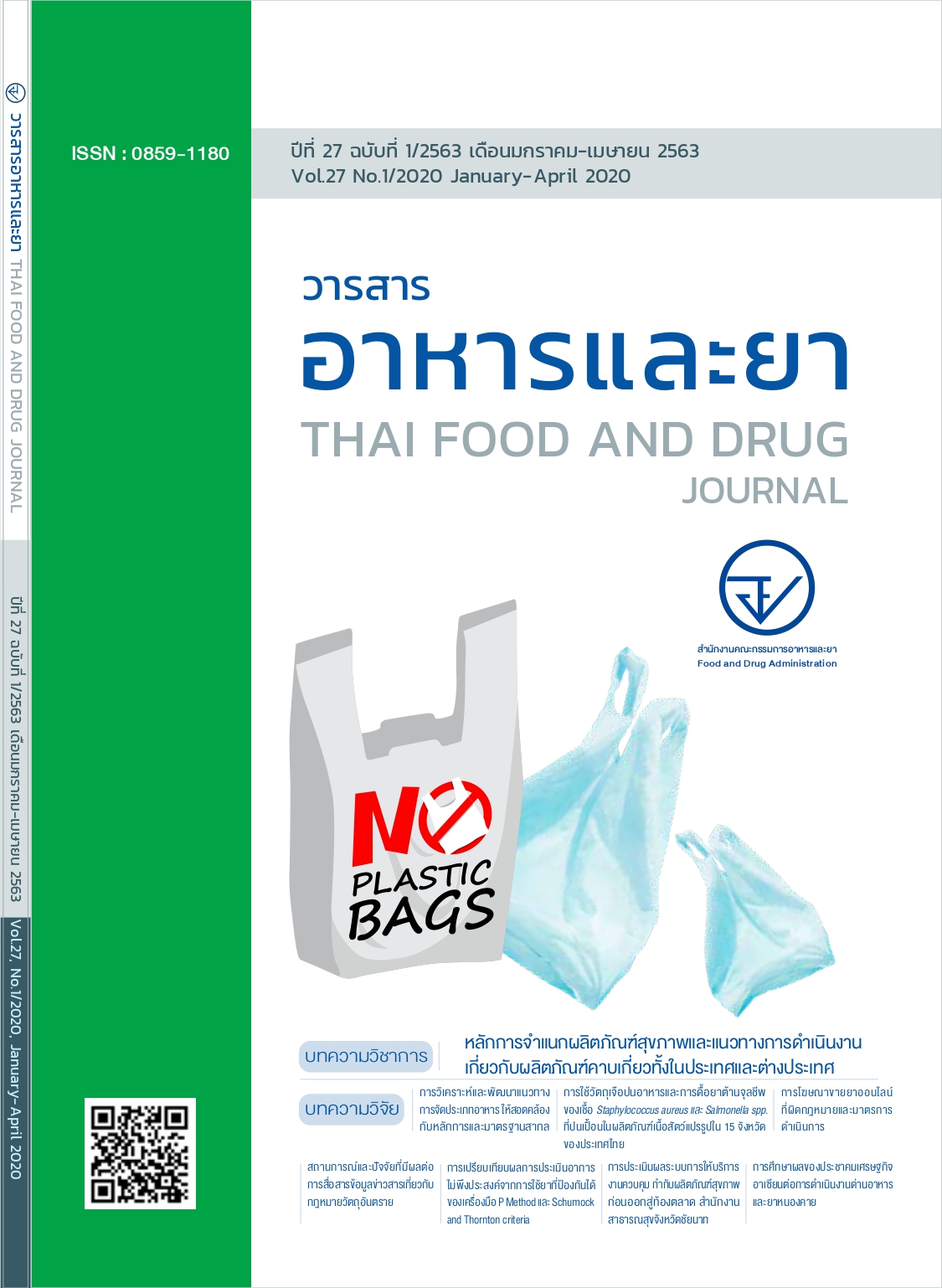สถานการณ์แลปัจจัยที่มีผลต่อการสื่อสารข้อมูลข่าวสาร เกี่ยวกับกฎหมายวัตถุอันตราย
Main Article Content
บทคัดย่อ
การศึกษานี้มีวัตถุประสงค์เพื่อ (1) ประเมินและวิเคราะห์สถานการณ์การสื่อสารข้อมูลข่าวสารเกี่ยวกับ
กฎหมายวัตถุอันตรายในปจั จุบัน ระหวา่ งสำนักงานคณะกรรมการอาหารและยา (อย.) กับผู้ประกอบการวัตถุอันตราย
และพนักงานเจ้าหน้าที่ตาม พ.ร.บ.วัตถุอันตราย พ.ศ. 2535 (2) ค้นหาและวิเคราะห์ปัจจัยที่มีผลต่อการสื่อสาร
และ (3) ค้นหาความต้องการให้ปรับปรุงการเผยแพร่ข้อมูลข่าวสาร ดำเนินการศึกษาระหว่างเดือนธันวาคม 2561
ถึง กรกฎาคม 2562 โดยใช้แบบสอบถามที่ใช้กรอบแนวคิดตามทฤษฎีแบบจำลอง SMCR ของเบอร์โล (Berlo’s
SMCR Model) เก็บขอ้ มูลดว้ ยการสุ่มตัวอย่างแบบไมใ่ ชค้ วามนา่ จะเปน็ แบบจำเพาะเจาะจงในกลุ่มผู้ประกอบการ
วัตถุอันตราย 315 คน และกลุ่มพนักงานเจ้าหน้าที่ 93 คน วิเคราะห์ข้อมูลด้วยสถิติเชิงพรรณนา แจกแจงเป็น
ค่าความถี่ ร้อยละ ค่าเฉลี่ย ส่วนเบี่ยงเบนมาตรฐาน และทดสอบค่าทีแบบกลุ่มเดียว (One Sample t-test)
เพื่อสรุปผลไปยังประชากรที่ศึกษา ผลการศึกษาพบว่า (1) กลุ่มตัวอย่างมีศักยภาพสูงในการเข้าถึงข้อมูลข่าวสาร
เกี่ยวกับกฎหมายวัตถุอันตรายผ่านทางอินเทอร์เน็ต โดยนิยมค้นหาจากเว็บไซต์ของกลุ่มควบคุมวัตถุอันตราย อย.
(2) ในชว่ งเดือนกรกฎาคม ถึง ธันวาคม 2561 กลุ่มตัวอย่างไดรั้บขอ้ มูลขา่ วสารจากเว็บไซตด์ ังกลา่ ว หนังสือราชการ
จาก อย. และการอบรม ประชุม สัมมนาที่จัดโดยกลุ่มควบคุมวัตถุอันตรายเป็นหลัก ซึ่งข้อมูลที่ได้รับส่วนใหญ่
มีความยากง่ายต่อความเข้าใจ และความเหมาะสมของรูปแบบการนำเสนอในระดับปานกลาง และระบุว่ามีประโยชน์
ตอ่ ผู้รับสารมาก (3) เมื่อแปลผลการสำรวจไปยังประชากร ตามองคป์ ระกอบการสื่อสาร 4 ดา้ น พบวา่ (3.1) ผู้สง่ สาร:
ต้องปรับปรุงการส่งข้อมูลข่าวสารให้รวดเร็วขึ้น วางแผนการส่งข้อมูลล่วงหน้า และประชาสัมพันธ์ช่องทาง
การสื่อสารต่าง ๆ ของ อย. (3.2) ข้อมูลข่าวสาร: ต้องปรับปรุงเนื้อหาและเทคนิคการนำเสนอที่ใช้ภาษาเข้าใจง่าย
ไม่ซับซ้อน และจดจำง่าย (3.3) ช่องทางการสื่อสาร: ต้องเพิ่มการส่งข้อมูลข่าวสารทางอีเมลให้มากขึ้น และรูปแบบ
54 THAI FOOD AND DRUG JOURNAL : JANUARY-APRIL 2020
การสื่อสารใหม่ ๆ โดยเฉพาะ application LINE และ social media และ (3.4) ผู้รับสาร: อย. ต้องส่งเสริม
พัฒนาใหผู้้รับสารมีความรู้ ความเขา้ ใจพื้นฐานเกี่ยวกับกฎหมายวัตถุอันตราย และเสริมสรา้ งทัศนคติและพฤติกรรม
ให้เห็นถึงความสำคัญของการรู้และเข้าใจกฎหมายวัตถุอันตราย
Article Details
เอกสารอ้างอิง
2552).
2. Berlo DK. The Process of Communication:An Introduction to Theory and Practice.New York: Holt, Rinehart and Winston;1960.
3. บุญชม ศรีสะอาด. การแปลผลเมื่อใช้เครื่องมือรวบรวมข้อมูลแบบมาตราส่วนประมาณค่า. วารสารการวัดผลการศึกษา มหาวิทยาลัยมหาสารคาม
2539;2:64-70.
4. บุญชม ศรีสะอาด, บุญส่ง นิลแก้ว. การอ้างอิงประชากรเมื่อใช้เครื่องมือแบบมาตราส่วนประมาณค่ากับกลุ่มตัวอย่าง. วารสารการวัดผลการศึกษามหาวิทยาลัยมหาสารคาม 2535;3:22-25.
5. สุภัค ถาวรนิติกุล. การศึกษาแนวทางเพื่อพัฒนาสื่อประชาสัมพันธ์ของคณะเกษตร กำแพงแสนมหาวิทยาลัยเกษตรศาสตร์ วิทยาเขตกำแพงแสน.วารสารวิชาการ Veridian E-Journal 2557;7:1137-48.
6. อนงค์วดี จีระบุตร. การประชาสัมพันธ์เผยแพร่ผลงานวิจัยของสำนักงานคณะกรรมการวิจัยแห่งชาติ.วารสารวิชาการศรีปทุม ชลบุรี 2558;11:194-205.
7. จเรวัฒน์ เทวรัตน์. พฤติกรรมและความต้องการของผู้สมัครเรียนในการเปิดรับสื่อประชาสัมพันธ์ของศูนย์วิทยพัฒนา มหาวิทยาลัยสุโขทัยธรรมาธิราชนครศรีธรรมราช [ประเภทการวิจัยภาระงานประจำ].
นครศรีธรรมราช: มหาวิทยาลัยสุโขทัยธรรมาธิราช;2555.
8. เขมณัฏฐ์ มิ่งศิริธรรม. Social Media สื่อสร้างสรรค์เพื่อการศึกษา. วารสารวิชาการ Veridian E-Journal2556;6:72-81.


